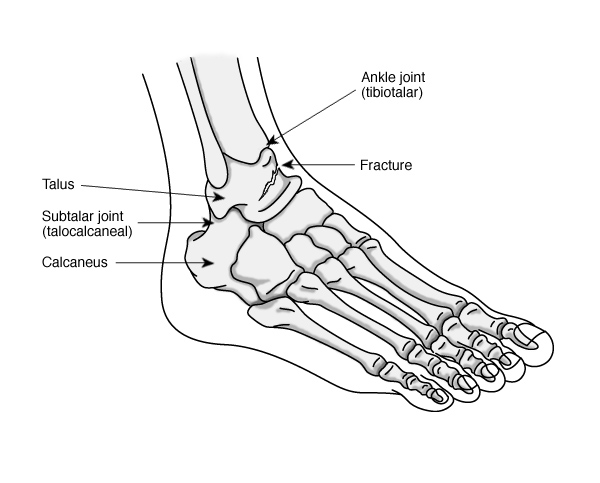Fracture of the Talus
The talus (TAY-lus) is a small bone that sits between the heel bone (calcaneus) and the two bones of the lower leg (tibia and fibula). It has an odd humped shape, somewhat like a turtle. The bones of the lower leg "ride" on top and around the sides to form the ankle joint. Where the talus meets the bones of the foot, it forms the subtalar joint, which is important for walking on uneven ground. The talus is an important connector between the foot and the leg and body, helping to transfer weight and pressure forces across the ankle joint.
Most injuries to the talus result from motor vehicle accidents, although falls from heights also can injure the talus. These injuries are often associated with injuries to the lower back. An increasing number of talar fractures result from snowboarding, which uses a soft boot that is not rigid enough to prevent ankle injuries.
Signs and symptoms
Most talar fractures are marked by
- acute pain
- an inability to bear weight
- considerable swelling and tenderness
A fracture that breaks through the skin has an increased risk of infection. Talar fractures that result from snowboarding injuries may be mistaken for ankle sprains because of the tenderness on the outer side of the ankle and severe bruising.
Diagnosis
Your doctor will examine your foot and ankle and ask you to describe how the injury occurred. He or she will order X-rays of your foot and ankle. In some cases, the X-ray will not show the fractures, so a computed tomography (CT) scan may be needed. These diagnostic tests will help pinpoint the location of the fracture. They also will show whether the bones are still aligned (nondisplaced fracture) or have shifted out of place (displaced fracture). Any loose bits of bone that may need to be removed also can be identified.
Your doctor will check the functioning of the nerves to the foot to ensure that there is no damage. He or she also will make sure that an adequate supply of blood is flowing to the toes and that pressure is not building in the muscles of the foot (compartment syndrome).
Treatment
A talar fracture that is left untreated or that doesn't heal properly will create problems for you later. Your foot function will be impaired, you will develop arthritis and chronic pain, and the bone may collapse.
Immediate first aid treatment for a talar fracture is to apply a well-padded splint around the back of the foot and leg from the toe to the upper calf. Elevate the foot above the level of the heart and apply ice for 20 minutes every hour or two until you can see a doctor. Don't put any weight on the foot.
In rare cases, a talar fracture can be treated without surgery if X-rays show that the bones have not moved out of alignment. You will have to wear a cast for at least six to eight weeks and will not be able to put any weight on the foot during that time. Afterwards, your doctor will give you some exercises to help restore the range of motion and strength to your foot and ankle. Most fractures of the talus require surgery to minimize later complications. The orthopaedic surgeon will realign the bones and use metal screws to hold the pieces in place. If there are small fragments of bone, they may be removed and bone grafts used to restore the structural integrity of the joint.
After the surgery, your foot will be put in a cast for six to eight weeks and you will not be able to put any weight on the foot for at least three months. As the bones begin to heal, your orthopaedist may order X-rays or a magnetic resonance image (MRI) to see whether blood supply to the bone is returning. If the blood supply is disrupted, the bone tissue could die, a condition called avascular necrosis or osteonecrosis. This could cause the bone to collapse. Even if the bones heal properly, you may still experience arthritis in later years. Most of the talus is covered with articular cartilage, which enables bones to move smoothly against each other. If the cartilage is damaged, the bones will rub against each other, resulting in pain and stiffness. Treatments for arthritis include activity modifications, ankle-foot orthoses, joint fusion, bone grafting and ankle replacement.

May 2002
All Information Copyright © American Academy of Orthopaedic Surgeons
www.aaos.org